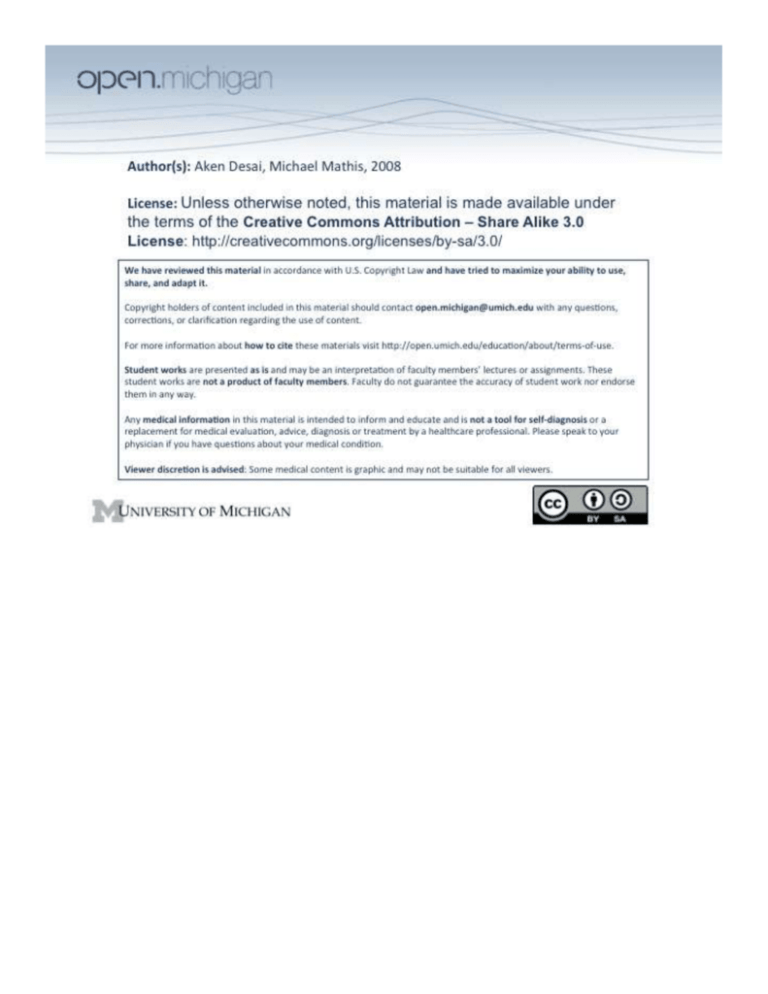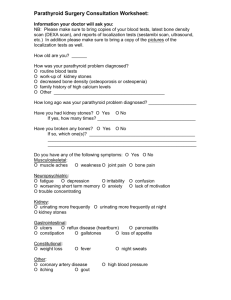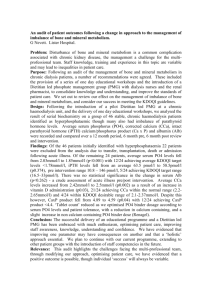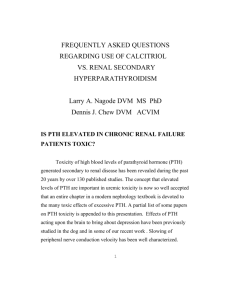You
advertisement

10-6-08 Calcium & Phosphorous Metabolism Calcium Balance Intake/Absorb – consume ~1000mg of Ca++ each day, ~150mg absorbed ECF – most Ca++ is here, half bound (proteins, complexes), half free ions (biologically active) Bone Dynamics – 500mg deposited, 500mg reabsorbed each day Kidney Filtration – about 9000mg filtered each day, ~150mg excreted Phosphate Balance Intake/Absorb – consume ~1200mg of Ca++ each day, ~800mg absorbed ECF/ICF – most PO4 is ECF, some ICF Bone Dynamics – 250mg deposited, 250mg reabsorbed each day Kidney Filtration – about 6000mg filtered each day, ~800mg excreted PTH Parathyroid Hormone (PTH) – secreted by parathyroids (4), regulated by: o Calcium – low serum [Ca++] stimulates PTH, (opposite inhibits) o Calcitriol (Vit. D) – low serum [Calcitriol] stimulates PTH, (opposite inhibits) o PO4 – high serum [PO4] stimulates PTH PTH Actions – more Ca++ , less PO4: o Increased Serum [Ca++] – mobilizes from bone, kidneys reabsorb, absorb from GI o Increased Serum [Calcitriol] – promotes synthesis in kidneys o Decreased Serum [PO4] – stops kidney reabsorption, stops GI absorption Calcitriol Actions – increases both [Ca++] and [PO4] o Activation – 7-DHC converted to cholecalciferol in skin liver 25-chole kidney 1,25 vit D (calcitriol) o Reabsorption from bone/GI of Ca++ and PO4 Hypercalcemia Differential Dx S/Sx – kidney stones, bone pain and fractures, HTN, constipation, asthenia Primary Hyperparathyroidism – increases serum [Ca++], increased [Calcitriol] o Symptoms – hypercalcemia, kidney stones, bone pain/fractures, HTN o Treatment – if serum [Ca++] < 11, monitor; if > 11, remove adenoma Malignancy – tumor of parathyroids, paraneoplastic syndrome, etc. Sarcoidosis – granulomas produce vitamin D hypercalcemia Thiazide Diuretics – limit Ca++ excretion don’t give to hypercalcemia patient (DM!) Kidney Stones Calcium Oxalate – complex which can form crystals kidney stones Kidney Stone Complications – pain (renal colic), hematuria, infection, obstruction, RF Kidney Stone Diet – you are more likely to have kidney stones if you have lower Ca++ intake! o High Ca++ intake keeps oxalate bound in gut, doesn’t form crystals easily here/excreted o Low Ca++ intake unbound oxalate is excreted by kidneys complex w/ Ca++ in urine stone Differential – idiopathic hypercalciuria, primary hyperPTH, hyperuricosuria, distal renal tubular acidosis Idiopathic Hypercalciuria – high levels of Ca++ in urine but not blood, no disease (1o HPTH, sarcoid) o Kidney Stones – more likely to have them if you have idiopathic hypercalciuria o Vitamin D – synthesized in excess, possible origin of idiopathic hypercalciuria o Genetics – seems to be autosomal dominant disorder o Treatment – give thiazide diuretics (increase Ca++ retention in blood), restrict Na+ intake Along with Na+ excretion is Ca++ excretion, thus limit Na+ excretion limit Ca++ Thiazides – don’t operate by this mechanism; instead Na+ excretion, Ca++ retention o Calcium restriction? No good for Tx will increase chances of kidney stones (oxalate) Renal Failure & Ca/P – Renal Osterodystrophy Renal Failure – unable to make vitamin D, thus low [calcitriol] low serum [Ca++], high [PO4] 2o Hyperparathyroidism – a high [PTH] tries to correct low serum [Ca++] and high [PO4], but to no avail o Short Run – adaptive, raises calcium, lowers PO4 in serum o Long Run – maladaptive, bone breakdown, other toxic effects Acidosis – low serum Ca++ low charge? whatever? H+ replaces in serum acidosis Treatment – decrease PTH (surgery), increase Vit. D (supplement), correct [Ca] & [PO 4], no aluminum Aluminum Renal Bone Disease – leads to aluminum accumulation, especially if on Al-PO4 supplements (now in disuse) Osteomalacia – low bone turnover, due to aluminum overload Osteitis Fibrosa Cystica – high bone turnover, disease instead from 1 o/2o hyper-PTH Clincial manisfestations – bone pain, fractures, myopathies, growth retardation, deformities, arthritis, perarticular/vascular calcification, calciphylaxis, tendon rupture, anemia, neuropathy, impotence, asthenia, HTN Treatment Goals – decrease serum PTH, increase serum calcitriol, decrease serum phosphorus, increase serum calcium, decrease aluminum Dietary phosphorus reduction Phosphate binders – aluminum (not used), calcium, sevelamer (polymer binding) Vitamin D Parathyroidectomy Aluminum chelation – if all else fails






